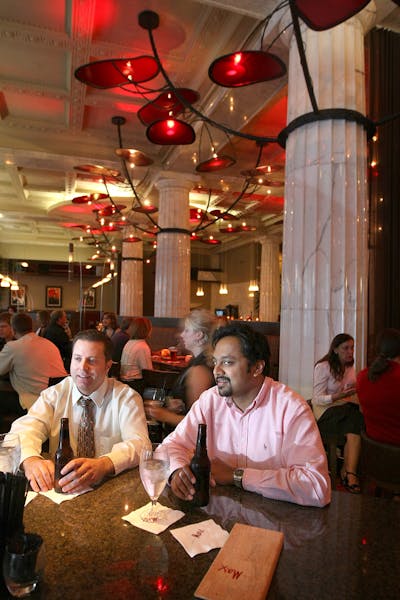Walking into the new W hotel in the Foshay Tower is like watching your maiden aunt lose 40 pounds, slip into a slinky black dress and head out to a party. The landmark 1929 building has been meticulously revived, with National Park Service historians bird-dogging every change. The redo, by Munge Leung Design Associates of Toronto with assistance from ESG of Minneapolis, is less a renovation than a resuscitation.
Outside, the venerable gray limestone landmark looks just like it did in 1929, when it opened to a three-day extravaganza two months before the financial crash. And it looks much like it did two years ago, before the massive rehab began. The 10-foot-high Foshay letters still dominate the top of the 30-story obelisk modeled after the Washington Monument. The two-story base still sits comfortably at 9th St. and Marquette Av. without any tacky additions.
Inside, it's not the place to visit your dentist anymore.
In recent years, the arcade leading from the Marquette Avenue entry to the elevator lobby had become claustrophobic. Now the false ceiling has been removed to reveal the full 12-foot height and the intricate plaster work, enough of which was found intact to make molds to re-create the rest. (That process took four months and an unexpected pile of money.)
The original glass-and-bronze storefronts along the arcade have been kept (why has anyone ever designed anything else for retail?) but they now reveal inviting spaces rather than blank walls.
Off to the right spreads the most magnetic lounge in the city, dubbed the Living Room by the brand-conscious W people. Most will admire the sexy, eccentric furniture -- furry black sofas, wine-colored leather chairs and white pleather-like club chairs -- but notice the space, too. The ceiling is lowered over the sitting area just enough to provide a sense of intimacy. The soaring two-story bar carries the eye upward.
The mix of textures titillates sight and touch: mirrored black surfaces, hanging beaded lamps, wrought-iron screens, furry pillows, leather stools and a subtle carpet in a diagonal design inspired by the arcade's original terrazzo floor. (Music that ranges from background to foreground and the use of scents ensure that other senses aren't neglected.)
If you can, draw yourself away to continue down the elegant marble-lined arcade to the amazingly dark reception area in the Foshay's elevator lobby. Here things go too far. Shocking pink lights wash the star-shaped coffered ceiling. A rounded screen wall defines the space behind the reception desks, whose prism-like fronts, back-lit with tropical colors, are modeled after perfume bottles. Silver trays of green apples, a few spotted orchids and black pots of wheat grass are the only ornaments.
It's visually stunning and you definitely know where to go to register or ask a question. But Foshay's original art-deco details -- the bronze and nickel postal box and directory, and the space itself -- are overpowered.
The bronze elevator doors are still there, of course, and the elevators now whisk rather than lug you upward, perhaps, if you're a guest, to one of the sleek and luxe rooms, which start at the compact Wonderful King with fun views of the city framed by the narrow windows for a mere $599 and progress to the 1,600-square-foot, two-bedroom E-Wow Suite on the 26th floor for $7,500. (The room décor echoes the theme established in the lounge: furry black and midcentury modern white with raspberry-colored munchie bars and the same deco-inspired carpet.)
Or, if you're a tourist or local, the elevators will take you to the delightfully refurbished museum and observation deck on the 30th floor. Or to Prohibition bar on the 27th floor, where Wilbur Foshay's original African mahogany-lined office with its quirky mezzanines and floor-to-ceiling butterfly windows creates a getaway worthy of 1920s Paris.
Haven't we all, at some time, yearned to escape to the exotic, romantic world of "Casablanca?" Here, at the Foshay W, we can.
Linda Mack is former architecture writer of the Star Tribune.
In heated western Minn. GOP congressional primary, outsiders challenging incumbent

Minnesota Sports Hall of Fame: A class-by-class list of all members

This retired journalist changed professional wrestling from Mankato

